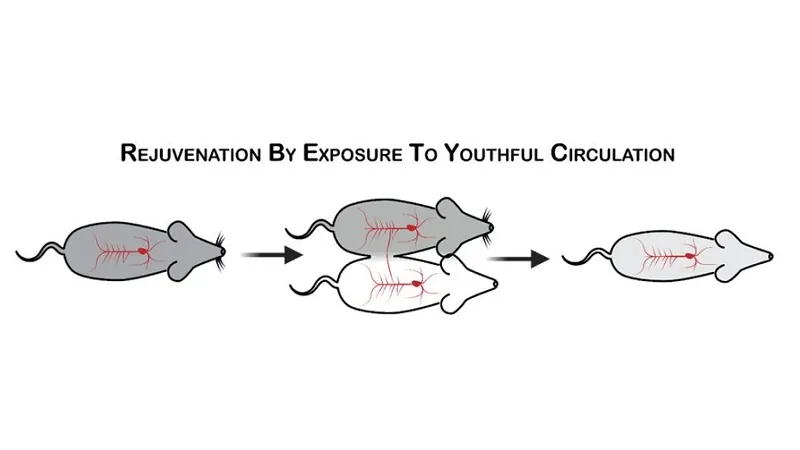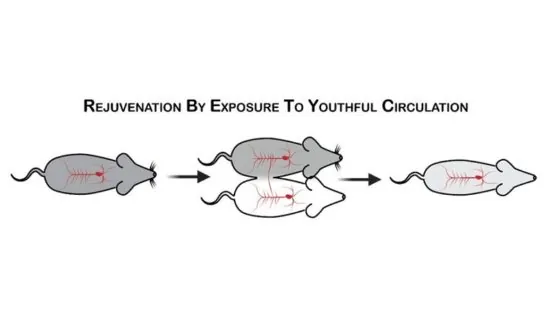A preprint published on bioRxiv, whose authors include well-known biogerontologist Vadim Gladyshev, has shown us many interesting details of the effects that heterochronic parabiosis has on aging mice.
An old concept studied in new depth
Heterochronic parabiosis is the linking of the circulatory systems of young and aged animals. While the researchers note that this has been studied since the 1950s, one of the most important papers on its effects was written by the Conboys in 2005 [1]. Removing old blood factors and introducing young ones has been shown to improve a great many tissues, including brain [2], muscle [1], and bone [3].
However, as the researchers point out, there had not yet been any long-term lifespan studies of mice given parabiosis and then detached later. By combining multi-omics techniques with a thorough lifespan study, the researchers sought to find out just how beneficial this process really is.
A long-term experiment with substantial results
This experiment featured three groups of mice. In addition to young and old mice having their circulatory systems connected, young mice were attached to other young mice and old mice were attached to other old mice to serve as control groups. The young mice were 3 months old, and the old mice were 20 months old, at the beginning of the experiment, and they stayed connected for three months.
The basic lifespan and body composition data was promising. The old, treated mice lived an average of six weeks longer than the old controls. Their body composition was improved; they had less fat mass and maintained muscle mass.
Improvements in epigenetics and gene expression
The epigenetic data was unequivocal. When tested with eight methylation clocks on two different platforms, the liver tissue of treated mice was found to be substantially and significantly younger than that of their untreated counterparts, and this persisted even two months after detachment.
The researchers also performed a gene expression analysis involving RNA sequencing. The gene expression of treated mice was, in many areas, more like that of young mice, particularly in areas related to fat metabolism and mTOR.
In all, the researchers ascertained that this intervention caused somewhat similar gene expression changes as other interventions known to extend healthspan and lifespan, such as caloric restriction (CR). The negative association with aging signatures was even stronger with parabiosis than with CR. Three months of parabiosis was found to be much more effective than five weeks in creating lasting changes to gene expression.
Among the genes found to be upregulated with parabiosis were Sirt3, which improves regeneration and decreases reactive oxygen species, along with Tert, which encodes for telomerase reverse transcriptase, a compound that lengthens telomeres and has been shown to have other positive effects. Dmnt3b, a gene that produces an enzyme associated with methylation, was downregulated, as were genes that encode the harmful senescence-associated secretory phenotype (SASP).
To conclude, our results indicate that biological age and molecular damage can be systemically reversed in a sustained manner following exposure to young circulation, and open exciting new avenues for research on parabiosis and its derivatives for organismal rejuvenation.
Conclusion
Obviously, the direct applicability of this research to humans is limited, as there will be no experiment in which an old person is connected to a young person’s bloodstream for three months. However, this murine experiment shows the power of old blood and young blood factors and provides insight into what blood exchange actually does to the metabolisms of animals.
If it is possible to isolate the various circulating signals and determine their differences, it may be possible to develop drugs that mimic them. If successful, such a treatment could be a readily accessible method of improving lifespan and healthspan.
Literature
[1] Conboy, I. M., Conboy, M. J., Wagers, A. J., Girma, E. R., Weissman, I. L., & Rando, T. A. (2005). Rejuvenation of aged progenitor cells by exposure to a young systemic environment. Nature, 433(7027), 760-764.
[2] Villeda, S. A., Plambeck, K. E., Middeldorp, J., Castellano, J. M., Mosher, K. I., Luo, J., … & Wyss-Coray, T. (2014). Young blood reverses age-related impairments in cognitive function and synaptic plasticity in mice. Nature medicine, 20(6), 659-663.
[3] Baht, G. S., Silkstone, D., Vi, L., Nadesan, P., Amani, Y., Whetstone, H., … & Alman, B. A. (2015). Exposure to a youthful circulation rejuvenates bone repair through modulation of ß-catenin. Nature communications, 6(1), 1-10.



